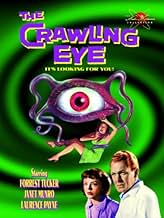A series of decapitations on a Swiss mountainside appear to be connected to a mysterious radioactive cloud.A series of decapitations on a Swiss mountainside appear to be connected to a mysterious radioactive cloud.A series of decapitations on a Swiss mountainside appear to be connected to a mysterious radioactive cloud.
Storyline
Did you know
- TriviaJohn Carpenter has said that this film, with its creatures hidden in the clouds, was partly the inspiration for his film The Fog (1980).
- GoofsAfter Brett gashes his forehead in a fight, they discover he does not bleed and that he is already dead. Yet Professor Crevette gives Brett an inject-able sedative in the arm. No blood means there is no way for the drug to travel to his brain.
- Quotes
Sarah Pilgrim: *Was* there an accident, Mister Klein?
Mayor Klein: O-On a mountain, uh, dese things sometimes happen.
- Crazy creditsThe film's opening credits flash onto the screen when the passenger train rolls into the darkness of a tunnel.
- ConnectionsEdited into FrightMare Theater: The Crawling Eye (2017)
Featured review
I have a huge and very soft spot for 1950s sci-fi films with freakish aliens and/or monsters. Be forewarned - my view of this film is definitely colored by my unhealthy interest in these films.
This is a true archetypal classic of the genre.
*** Weird psychic sisters, *** alien mystery clouds, *** giant creeping cyclopes with tentacles, *** secret government agencies investigating the paranormal, *** possession, *** zombies, ***
Forest Tucker(!)
This is a very entertaining low-fi, low-brow, B/W monster movie. I am convinced that the writers were asked to include every element of contemporary supernatural, sci fi and imaginative fiction stories and, kudos to them - they pulled it off! Stephen King's Dreamcatcher owes a huge debt to this beauty. If you think about it, Dreamcatcher is almost a rewrite of this film, with aliens that are just a little less ridiculous and a different narrative. And the biggest surprise of all - Forest Tucker can act! His F Troop character was not the only personality in his repertoire!
Remarkably, the absurdity of the plot is not used as an excuse for exceedingly bad special effects.
This is a little gem of a 50s pulp film. It's goofy as hell, fun, well executed, and well worth a sleepless night. Far more entertaining that the Creature from the Black Lagoon, and many others.
This is a true archetypal classic of the genre.
*** Weird psychic sisters, *** alien mystery clouds, *** giant creeping cyclopes with tentacles, *** secret government agencies investigating the paranormal, *** possession, *** zombies, ***
Forest Tucker(!)
- it's all here.
This is a very entertaining low-fi, low-brow, B/W monster movie. I am convinced that the writers were asked to include every element of contemporary supernatural, sci fi and imaginative fiction stories and, kudos to them - they pulled it off! Stephen King's Dreamcatcher owes a huge debt to this beauty. If you think about it, Dreamcatcher is almost a rewrite of this film, with aliens that are just a little less ridiculous and a different narrative. And the biggest surprise of all - Forest Tucker can act! His F Troop character was not the only personality in his repertoire!
Remarkably, the absurdity of the plot is not used as an excuse for exceedingly bad special effects.
This is a little gem of a 50s pulp film. It's goofy as hell, fun, well executed, and well worth a sleepless night. Far more entertaining that the Creature from the Black Lagoon, and many others.
- How long is The Crawling Eye?Powered by Alexa
Details
- Release date
- Country of origin
- Languages
- Also known as
- Die Teufelswolke von Monteville
- Filming locations
- Alliance Film Studios, St Margarets, Twickenham, Middlesex, England, UK(studio: made at Alliance Film Studios Ltd)
- Production company
- See more company credits at IMDbPro
- Runtime1 hour 24 minutes
- Color
- Aspect ratio
- 1.66 : 1
Contribute to this page
Suggest an edit or add missing content




























